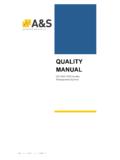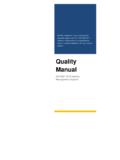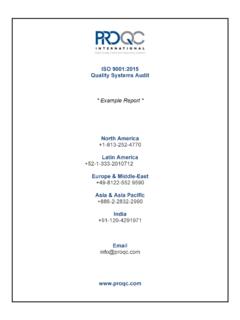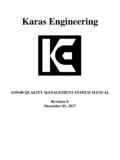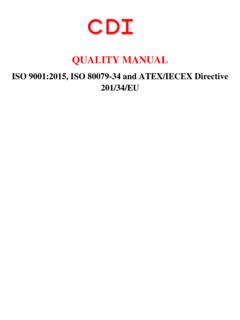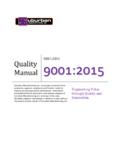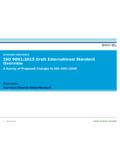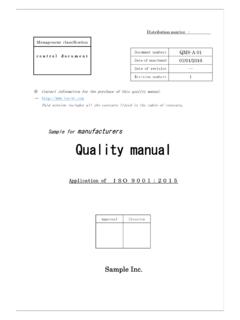Transcription of Comparison Matrix ISO 9001:2015 vs ISO 9001:2008
1 Comparison Matrix iso 9001 : 2015 vs ISO 9001:2008 iso 9001 : 2015 clause ISO 9001:2008 clause Comments 4 Context of the organization Understanding the organization and its context The organization shall determine external and internal issues that are relevant to its purpose and its strategic direction and that affect its ability to achieve the intended result(s) of its quality management system. The organization shall monitor and review information about these external and internal issues. NOTE 1 Issues can include positive and negative factors or conditions for consideration. NOTE 2 Understanding the external context can be facilitated by considering issues arising from legal, technological, competitive, market, cultural, social and economic environments, whether international, national, regional or local.
2 NOTE 3 Understanding the internal context can be facilitated by considering issues related to values, culture, knowledge and performance of the organization. No equivalent clause Generally organizations address this by developing a vision statement and a mission statement; these are developed into a long term strategic direction and a strategic plan. These further lead to shorter 3 to 5 year business development plans, which are supported by annual goals and objectives. For small to medium size organizations, these may be unstated and undocumented and be in the mind of the owner or may not exist at all. The issues can relate to: Legal (FDA, FAA, DOT, EPA, OHSA) Market & competition Technology development Cultural & social directions Economic development International Trade Understanding the needs and expectations of interested parties Due to their effect or potential effect on the organization s ability to consistently provide products and services that meet customer and applicable statutory and regulatory requirements, the organization shall determine: a) the interested parties that are relevant to the quality management system.
3 B) the requirements of these interested parties that are relevant to the quality No equivalent clause Organization s interested parties include: Owner(s) individuals, investment companies, corporate ownership, stockholders Employees Regulators Customers Competitors Trade Associations State and local business community Owners Suppliers management system. The organization shall monitor and review information about these interested parties and their relevant requirements. Neighbors Determining the scope of the quality management system The organization shall determine the boundaries and applicability of the quality management system to establish its scope. When determining this scope, the organization shall consider: a) the external and internal issues referred to in ; b) the requirements of relevant interested parties referred to in ; c) the products and services of the organization.
4 The organization shall apply all the requirements of this International Standard if they are applicable within the determined scope of its quality management system. The scope of the organization s quality management system shall be available and be maintained as documented information. The scope shall state the types of products and services covered, and provide justification for any requirement of this International Standard that the organization determines is not applicable to the scope of its quality management system. Conformity to this International Standard may only be claimed if the requirements determined as not being applicable do not affect the organization s ability or responsibility to ensure the conformity of its products and services and the enhancement of customer satisfaction. Quality manual The organization shall establish and maintain a quality manual that includes a) the scope of the quality management system, including details of and justification for any exclusions (see )
5 , Scope requirements are more explicit Required Content Types of products & services Application of all requirements from iso 9001 that are applicable if they have activities/processes they are to be included Boundaries of the QMS Justification for any exclusions Scope determined by considering external & internal issues, requirements of interested parties & products & services Quality management system The organization shall establish, implement, maintain and continually improve a quality management system, including the processes needed and their interactions, in accordance with the requirements of this International Standard. The organization shall determine the processes needed for the quality management system and their application throughout the organization, and shall: a) determine the inputs required and the outputs expected from these processes; b) determine the sequence and interaction of these processes; c) determine and apply the criteria and methods (including monitoring, measurements and related performance indicators) needed to ensure the effective operation and control of these processes; d) determine the resources needed for these processes and ensure their availability; e) assign the responsibilities and authorities for these processes; f) address the risks and opportunities as determined in accordance with the requirements of.
6 G) evaluate these processes and implement any changes needed to ensure that these processes achieve their intended results; h) improve the processes and the quality management system. To the extent necessary, the organization shall: a) maintain documented information to support the operation of its processes; General requirements The organization shall establish, document, implement and maintain a quality management system and continually improve its effectiveness in accordance with the requirements of this International Standard. The organization shall a) determine the processes needed for the quality management system and their application throughout the organization (see ), b) determine the sequence and interaction of these processes, c) determine criteria and methods needed to ensure that both the operation and control of these processes are effective, d) ensure the availability of resources and information necessary to support the operation and monitoring of these processes, e) monitor, measure where applicable, and analyse these processes, and f) implement actions necessary to achieve planned results and continual improvement of these processes.
7 These processes shall be managed by the organization in accordance with the requirements of this International Standard. Where an organization chooses to outsource any process that affects product conformity to requirements, the organization shall ensure control over such processes. The type and extent of control to be applied to these outsourced processes shall be defined within the quality management system. NOTE 1 Processes needed for the quality Process Approach additions/changes Assign responsibilities & authorities for the processes Address risks and opportunities with link to Discussion of outsourced processes moved to a reference in clause which refers to control described in clause basically the purchasing requirements b) retain documented information to have confidence that the processes are being carried out as planned.
8 Management system referred to above include processes for management activities, provision of resources, product realization, measurement, analysis and improvement. NOTE 2 An outsourced process is a process that the organization needs for its quality management system and which the organization chooses to have performed by an external party. NOTE 3 Ensuring control over outsourced processes does not absolve the organization of the responsibility of conformity to all customer, statutory and regulatory requirements. The type and extent of control to be applied to the outsourced process can be influenced by factors such as a) the potential impact of the outsourced process on the organization's capability to provide product that conforms to requirements, b) the degree to which the control for the process is shared, c) the capability of achieving the necessary control through the application of 5 Leadership Leadership and commitment General Top management shall demonstrate leadership and commitment with respect to the quality management system by: a) taking accountability for the effectiveness of the quality management system; b) ensuring that the quality policy and quality objectives are established for the quality management system and are compatible with the context and strategic direction of the organization.
9 C) ensuring the integration of the quality management system requirements into the organization s business processes; Management commitment Top management shall provide evidence of its commitment to the development and implementation of the quality management system and continually improving its effectiveness by a) communicating to the organization the importance of meeting customer as well as statutory and regulatory requirements, b) establishing the quality policy, c) ensuring that quality objectives are established, d) conducting management reviews, and e) ensuring the availability of resources. Top Management new/now explicit commitments: Accountability for effectiveness Ensuring QMS achieves intended results Compatible with Strategic Direction of organization Integration with business processes (interpreted in context of nature of organization for profit; not for profit; private, public) d) promoting the use of the process approach and risk-based thinking; e) ensuring that the resources needed for the quality management system are available; f) communicating the importance of effective quality management and of conforming to the quality management system requirements; g) ensuring that the quality management system achieves its intended results; h) engaging, directing and supporting persons to contribute to the effectiveness of the quality management system; i) promoting improvement.
10 J) supporting other relevant management roles to demonstrate their leadership as it applies to their areas of responsibility. NOTE Reference to business in this International Standard can be interpreted broadly to mean those activities that are core to the purposes of the organization s existence, whether the organization is public, private, for profit or not for profit. Customer Focus Top management shall demonstrate leadership and commitment with respect to customer focus by ensuring that: a) customer and applicable statutory and regulatory requirements are determined, understood and consistently met; b) the risks and opportunities that can affect conformity of products and services and the ability to enhance Customer focus Top management shall ensure that customer requirements are determined and are met with the aim of enhancing customer satisfaction (see and ).
